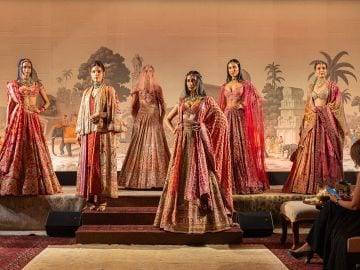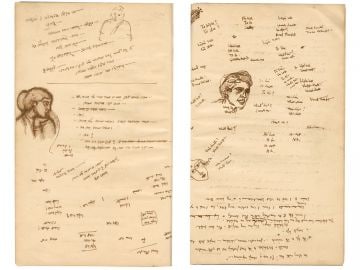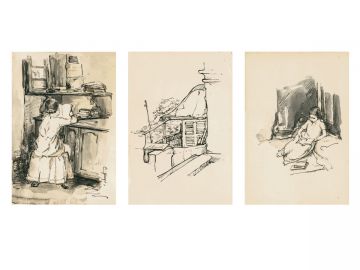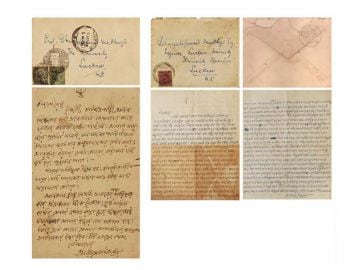Teach and tell: The gurus of art
Some of India’s greatest artists have also been teachers, but have they merely handed over a tradition or inspired fresh thinking?
Image by : Courtesy: DAG Modern Archives
Image by : Courtesy: DAG Modern Archives
[Gulam Mohammed Sheikh]
Image by : Courtesy: DAG Modern Archives
Image by : Courtesy: DAG Modern Archives
(1871-1951)
Taught at: Government School of Art, Calcutta, as vice-principal
Abanindranath Tagore’s influence as a teacher can hardly be restricted to his alma mater where he was invited to teach by the great orientalist, EB Havell. The Tagore family residence Jorasanko, which is now part of Rabindra Bharati University, was instrumental in mentoring and teaching numerous artists directly and indirectly in what has since come to be known as the Bengal School, of which he was the initiator. Helming the revivalist school, which reclaimed art from the clutches of British realism, Abanindranath Tagore looked to India’s miniature tradition as well as the Ajanta murals, as also Japanese wash painting, for inspiration. His works on mythical and historical subjects are finely detailed and considered treasures of Indian modern art. While the salon at Jorasanko involved itself with all cultural activities, as a teacher Abanindranath Tagore not only trained a number of prized students, he was also responsible for teaching his star pupil Nandalal Bose, who would go on to change the course of Indian modern art.
Image by : Courtesy: DAG Modern Archives
Image by : Courtesy: DAG Modern Archives
[Abanindranath Tagore]
Image by : Courtesy: DAG Modern Archives
Image by : Courtesy: DAG Modern Archives
(1924-2016)
Taught at: Faculty of Fine Arts, MS University, Baroda, and Kala Bhavana, Visva-Bharati University, Santiniketan
Manida—as this Keralite, who adopted Santiniketan as his own and was a revered figure in Baroda, was known — passed away during the writing of this article. As a student of three of India’s earliest modernists and teachers in Santiniketan—Nandalal Bose, Benode Behari Mukherjee and Ramkinkar Baij—Subramanyan was influenced by his alma mater, but his Baroda years taught him to think in a manner that was made more distinctive by the unique quality of his paintings. The public knew him for his satirical reverse paintings on murals and glass, but where Subramanyan triumphed was in his ability to bridge the real and the imagined, the ability to impose societal nuances on the mythical, building an episodic narrative that was responsible for many a giggle despite its serious intent. A highly-regarded modernist and a great teacher, Subramanyan’s ability to laugh may yet hold the rising interest in his work in good stead.
Image by : Courtesy: DAG Modern Archives
Image by : Courtesy: DAG Modern Archives
[KG Subramanyan]
Image by : Courtesy: DAG Modern Archives
Image by : Courtesy: DAG Modern Archives
(1911-77)
Taught at: Government College of Fine Arts, Chennai, of which he was principal
Referred to as a child prodigy for his early start as an artist, Paniker went on to form the Progressive Painters’ Association and, later, the Cholamandal Artists’ Village. Influenced by India’s hidden language of symbols in traditional art, he chose to work in the abstract, influenced also by calligraphy. He chose bright colours, reflecting the local landscape, but also inspired by the Impressionists. Associated with the Madras Art Movement as its key motivator, not only did he provide southern artists growing confidence, as an abstractionist he was able to use established heritage to embody his work with roots, one of the few artists from the region to invest in this, since tantra-based abstraction had become the norm in North India.
Image by : Courtesy: DAG Modern Archives
Image by : Courtesy: DAG Modern Archives
[KCS Paniker]
Image by : Courtesy: DAG Modern Archives
Image by : Courtesy: DAG Modern Archives
(1882-1966)
Taught at: Kala Bhavana at Visva-Bharati University, Santiniketan, on Rabindranath Tagore’s persuasion
Abanindranath Tagore’s student, who went on to outshine his teacher, Bose’s career can be divided into two parts—the first in Calcutta (now Kolkata) where he soon became renowned for his amazingly elegant paintings in the style that came to be known as the Bengal School, and then at Santiniketan where he was associated with a native expressionism that went on to represent India’s first indigenous art movement. In particular, the recording of his journal in the form of postcards—drawings based on his travels, daily observations and as notes to family and friends. Jawaharlal Nehru commissioned him to paint (with a posse of artists) the first two hand-calligraphed copies of the Constitution of India.
Image by : Courtesy: DAG Modern Archives
Image by : Courtesy: DAG Modern Archives
[Nandalal Bose]
Image by : Courtesy: DAG Modern Archives
Image by : Courtesy: DAG Modern Archives
(1916-2006)
Taught at: Faculty of Fine Arts, MS University, Baroda, and visiting fellow at Kala Bhavana, Visva-Bharati University, Santiniketan, and Banaras Hindu University, Varanasi
The quintessential teacher—he established the sculpture department at MS University—he studied at Santiniketan under Ramkinkar Baij, India’s first modernist, and went on to teach sculptors Raghav Kaneria and Dhruva Mistry. A sparse modernist, his sculptures were about form and movement, parsed of anything that was inessential or superfluous. Though he did portrait busts of Mahatma Gandhi and Jawaharlal Nehru, among others, it was these austere works that caught the imagination of a collecting, art-loving public. This was especially notable given how abstraction in sculpture is difficult to achieve and harder to communicate. Chaudhuri’s big achievement was the setting up of the Garhi art studios in New Delhi, and he was also responsible for establishing Bhopal’s Museum of Man at Bharat Bhavan.
Image by : Courtesy: DAG Modern Archives
Image by : Courtesy: DAG Modern Archives
[Sankho Chaudhuri]
Image by : Courtesy: DAG Modern Archives
Image by : Courtesy: DAG Modern Archives
(1910-92)
Taught at: Faculty of Fine Arts, MS University, Baroda
Along with Gulam Sheikh, NS Bendre was the kind of teacher who encouraged students from different backgrounds to join art classes, sometimes also organising or paying for their fees. Among those he encouraged to study art was MF Husain, whom he met in Indore, and Gulam Rasool Santosh, who was introduced to him by SH Raza. An inspiring teacher, Bendre was considered a great colourist and went on to emerge as the country’s best-known pointillist. His subjects were often pastoral and before he became a master of pointillism, he dabbled in cubism, expressionism and abstraction, fusing together European styles that he experimented with before finding his own distinct voice, which was based in an indigenous vocabulary that had been sparked by the early Santiniketan artists and also Calcutta-based Jamini Roy, arguably India’s earliest modernist.
Image by : Courtesy: DAG Modern Archives
Image by : Courtesy: DAG Modern Archives
[NS Bendre]
Image by : Courtesy MAP / Tasveer
Image by : Courtesy MAP / Tasveer
(b. 1941)
Taught at: College of Art, Delhi; he serves as Head of Department at Triveni Kala Sangam, New Delhi
Many artists have passed through Rameshwar Broota’s mentorship, particularly at Triveni. He might be said to have influenced generations of painters. As a teacher, he has never imposed his own style or authority, and his students have benefitted from his presence and approval, to continue experimenting till they arrive at their own oeuvres. Broota’s own style—aside from a time when he satirically commented on the Emergency with a series of apes—has been a masculine manner in which he paints canvases in black and white representing abstracts or (mostly) male torsos. He scratches through the surface of the paint using razor blades to create depth and perspective. Broota’s canvases are usually overpowering, as much in size as in the intense close-up he offers of his subject, reflecting their honesty and purity.
Image by : Courtesy: DAG Modern Archives
Image by : Courtesy: DAG Modern Archives
[Rameshwar Broota]
Image by : Courtesy: DAG Modern Archives
Image by : Courtesy: DAG Modern Archives
(1867-1944)
Taught at: Sir JJ School of Art, Bombay (now Mumbai), of which he became both headmaster and vice-principal
Trained by the British artist John Griffiths, Dhurandhar became such a master of realism, he was considered superior to his senior but peer artist Raja Ravi Varma. Like Ravi Varma, Dhurandhar’s subjects mostly centred around the mythological and the historical. He was also commissioned to paint portraits, and his works were exhibited in London. He went on to train a new generation of artists in the academic style and formed the curricula at his alma mater—Sir JJ School of Art. Painting in oil, a number of his paintings were turned into prints and calendars (and used in advertisements), and he remains one of the foremost exponents of the early style of Western painting that became popular with members of India’s princely families, British grandees as well as Parsi collectors.
Image by : Courtesy: DAG Modern Archives
Image by : Courtesy: DAG Modern Archives
[MV Dhurandhar]
Image by : Courtesy: DAG Modern Archives
Image by : Courtesy: DAG Modern Archives
There have been numerous teacher-artists whose works have survived time, or whose teaching skills have proved to be legendary. One of the most interesting of these is Ramkinkar Baij (1906-80) in Santiniketan. A student at the university, he joined the faculty of Kala Bhavana to teach sculpture and was singularly responsible for veering his students away from British-taught realism, or the more sentimental versions of early modernism in stone and metal, to newer materials and a representation that was distorted. Among his more important students is KS Radhakrishnan who also curated a retrospective on his teacher and guide.
Image by : Courtesy: DAG Modern Archives
Image by : Courtesy: DAG Modern Archives
[Untitled by BC Sanyal]
BC Sanyal (1901-2003) established the Lahore School of Art, which became an important centre of education and practice, and went on to teach art at Modern School, New Delhi, post independence, and was responsible for guiding the careers of many artists.
Image by : Courtesy: DAG Modern Archives
Image by : Courtesy: DAG Modern Archives
At the Faculty of Fine Arts, Baroda, two artists who influenced numerous students were Nasreen Mohamedi (1937-90) and Jeram Patel (1930-2016). Patel, known for making works in wood that he burnt with the help of a blowtorch, was a member of Group 1890 and persisted with his unique form of art-making even though it was difficult to understand, or market.
Image by : Courtesy: DAG Modern Archives
Image by : Courtesy: DAG Modern Archives
Nasreen Mohamedi was no different, and it is only with her recent showing in New York that she has begun to get due credit.
Image by : Courtesy: DAG Modern Archives
Image by : Courtesy: DAG Modern Archives
In New Delhi, Sailoz Mukherjea (1906-60) taught landscape art at the Delhi Polytechnic (later College of Art, Delhi), and among his star pupils was artist Paramjit Singh. Sailoz is one of India’s nine ‘National Treasures’ and created a unique style where he would scratch the painted surface with the sharp end of his paint brush.
Another artist who taught at the College of Art, Delhi, was Bimal Dasgupta (1917-95), considered a master of abstract painting. His works recreate independent geographies that arise from a fertile imagination of imaginary lands.
Image by : Courtesy: DAG Modern Archives
Image by : Courtesy: DAG Modern Archives
Bengal style artist Sarada Ukil (1888-1940) taught at Modern School and with his brothers Ranada and Barada went on to teach artists in the capital.





